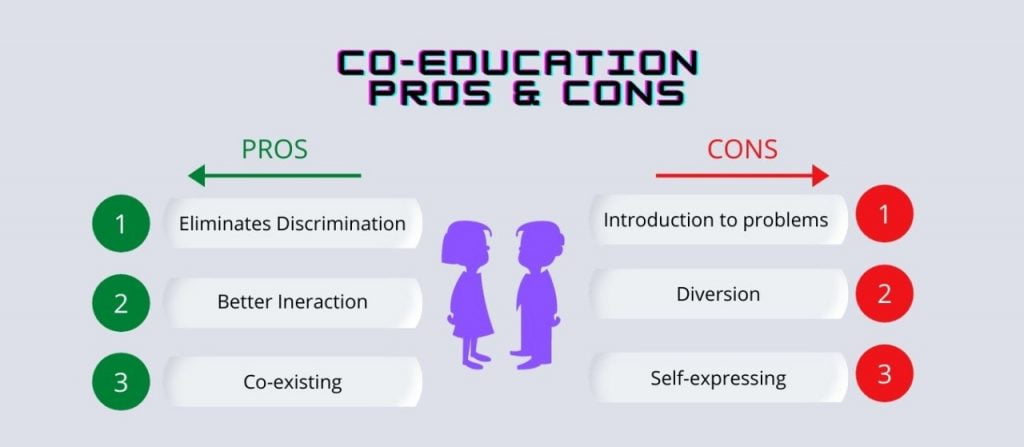The most important aspect of a human’s life is education. Previously, we learned things from nature and only thrived to survive, but today’s world is much more than surviving. We need to make something valuable out of ourselves in the modern age. At the same time, our views must be progressive and broad-minded, for which education is a must.
Co-education is basically the normal form of education for us where boys and girls go to school and study together. It is also known as mixed-gender education, that is, educating both genders simultaneously. In earlier times, there was a need for separate schools for both genders since that was the stage where the importance of education was still being implemented in the minds of the people. But today, everyone knows how crucial education is for their child. Besides, people are now broad-minded enough to opt for co-education for their kids. However, in some parts, the question gets raised on the credibility of co-educational institutes even today.
In this article, we’ll be discussing both sides of co-education, pros as well as cons.
Pros of Co-education:
1.Better interaction – you may have noticed that a lot of people get uncomfortable due to fear of interacting with their opposite gender. This happens because they don’t have any prior experience with the opposite gender. Co-education can delicately solve this issue that doesn’t seem much of an issue but is one. If children get to interact with their opposite gender from their school age, then they’ll get a better understanding and perspective for them. This will also help them later in life as a moral development to their personality.
2.Eliminates discrimination – finally, the century-old gender discrimination is coming to an end with the maximum youth understanding the importance of equality. Co-education has begun before the 90s period in most parts of India. From 2000, it became quite prominent all over the country, which is why today’s young generation is more open to the concept of equality and doesn’t believe in any sort of discrimination.
3.Co-existing – co-existence of both genders has been a known argument for ages. Society generally picks co-existence with the wrong perspective where one of the two genders is supposed to suppress themselves based on different topics. For instance, if the topic is about earning then, the females are suppressed; and if the topic is about menstruation, the males are supposed not to bother. Co-education amply encourages the co-existence of both genders irrespective of what situation arises. They both will have different views, and both can share and solve together. This also teaches them about diversity and how to respect that, no matter how different the other person is. To be precise, co-education can passively teach the youth to respect all genders beyond males and females.
1.Progression – learning together with the opposite gender while neglecting all sorts of illogical grounds for discrimination leads to those students bringing a progressive future later in life. The progressive thoughts we get to see today over social media have their roots in their school education.
2.Saved resources – building a separate institution for both genders in every city and every town of the country means consumption of more resources. Understanding the value and thereby opting for co-education will lead to the saving of tremendous resources. This will further enable the government to establish educational facilities in every town of the country with the saved resources.

Cons of Co-education:
1.Introduction to problems – generally, the schools only introduce common life problems that are faced by everyone. But the separate ones that are faced by both genders are not talked about or very well-acknowledged. It leads to both genders getting introduced to their respective problems only when they face them in real life. One such example of a problem would be the ideologies (stereotypes) set on the genders.
2.Diversion – many times, we get to hear that the students get diverted from their studies owing to their attraction towards the opposite gender. However, this is a natural issue that needs to be dealt with by the students themselves; interference can cause unnecessary outcomes. If they dealt with it appropriately without affecting their studies, then we can say they’ve learned the art of managing.
3.Self-expressing – while we’re saying that co-education will make it comfortable for both genders to speak and express themselves in front of their opposites, it might be challenging to begin with in the school age. If a student becomes resistant to expressing due to fear from his/her school life, then it can lead to another problem of hoarding one’s thoughts and never venting out.
So co-education, like any other concept in the world, has both sides which we’ve just seen. But overall, making both genders study, learn and gain life experience together would bring a lot of positive shifts and developments in their personalities. They both would learn to understand each other well, and thereby, the gender-based conflicts would start decreasing.
If we talk about a future benefit of co-education other than personality development, then creativity would be the word. When males and females with their different, unique ideologies work together without any discrimination, the chances of generating creative ideas would be immense.









